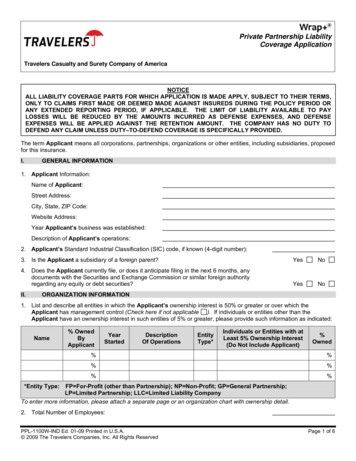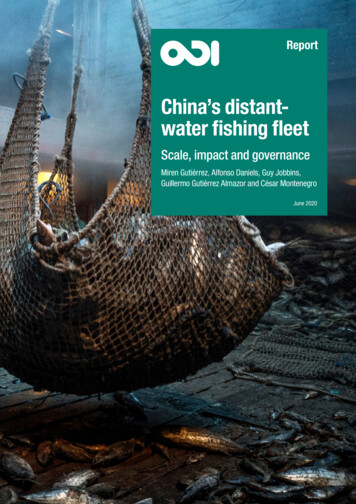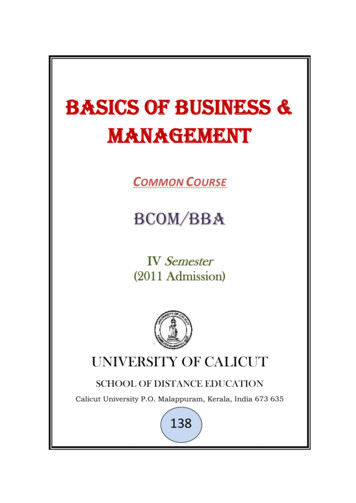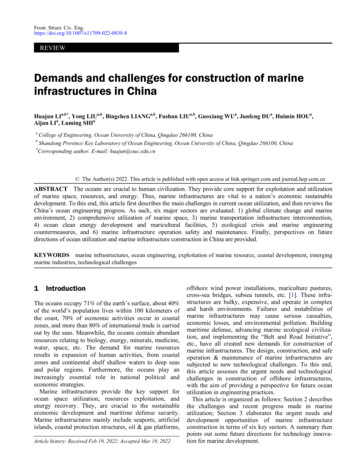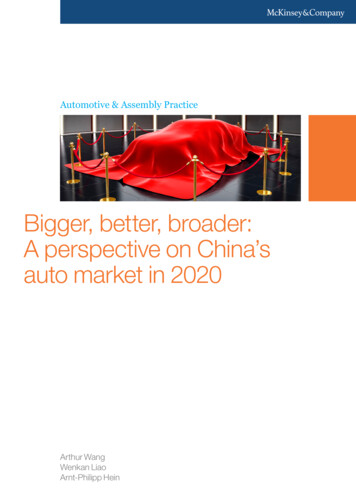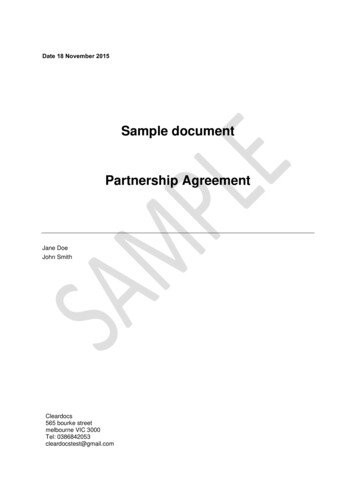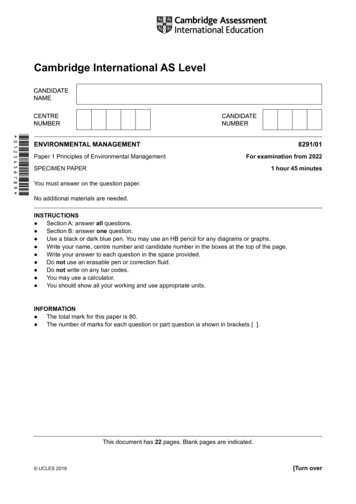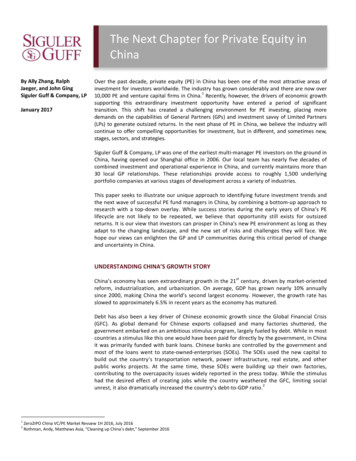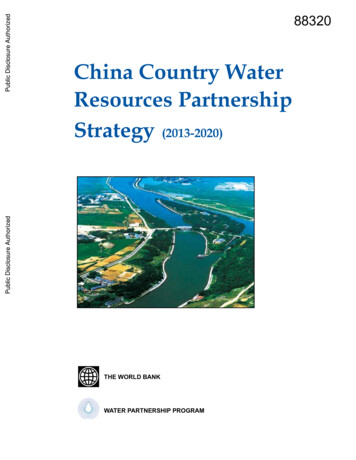
Transcription
Public Disclosure AuthorizedPublic Disclosure AuthorizedPublic Disclosure AuthorizedPublic Disclosure Authorized88320China Country WaterResources PartnershipStrategy (2013-2020)THE WORLD BANKWATER PARTNERSHIP PROGRAM
China Country Water Resources Partnership Strategy 2013 The World Bank1818 H Street NWWashington DC 20433Telephone: 202-473-1000Internet: www.worldbank.orgThis work is a product of the staff of The World Bank with external contributions.The findings, interpretations, and conclusions expressed in this work do notnecessarily reflect the views of The World Bank, its Board of Executive Directors or thegovernments they represent.The World Bank does not guarantee the accuracy of the data included in this work.The boundaries, colors, denominations, and other information shown on any map inthis work do not imply any judgment on the part of The World Bank concerning thelegal status of any territory or the endorsement or acceptance of such boundaries.Rights and PermissionsThe material in this work is subject to copyright. Because The World Bank encouragesdissemination of its knowledge, this work may be reproduced, in whole or in part, fornoncommercial purposes as long as full attribution to this work is given.Any queries on rights and licenses, including subsidiary rights, should be addressedto the Office of the Publisher, The World Bank, 1818 H Street NW, Washington, DC20433, USA; fax: 202-522-2422; e-mail: pubrights@worldbank.org.
Table of ContentsAcknowledgments.VIIAbbreviations and Acronyms.IXExecutive Summary.XIChapter I – Introduction. 11.1 Background. 11.2 Existing Strategies and Principles . 31.3 Focus Areas of a New Partnership Strategy. 41.4 Road Map for Achieving Strategic Goals . 6Chapter II - China’s Water Resources and Strategic Issues. 72.1 Water Resources Overview. 72.2 Trends and the Impact of Climate Change. 92.3 Strategic Issues for China’s Water Resources. 92.4 Main Issues in China’s Major River Basins. 16Chapter III - Country Context of Water Sector Development. 193.1 Development Progress in China’s Water Sector. 193.2 China’s Strategic Goals and Targets for 2020. 27Chapter IV - Cooperation between China and World Bank. 334.1 Review of Past Cooperation. 334.2 Flood Protection and Drought Mitigation. 364.3 Irrigated Agricultural Water Savings . 364.4 Enhanced Water Withdrawal Permit System. 394.5 Water/Soil Erosion Control. 404.6 Participatory Irrigation Management . 414.7 Water Pollution Control. 414.8 Impact of Climate Change . 414.9 Integrated Water Resources Management. 42China Country Water Resources Partnership StrategyIII
Table of ContentsChapter V - Partnership Strategy for Sustainable and Green Growth. 495.1 Guiding Principles of Partnership Strategy. 505.2 Partnership Strategy for Flood Protection and Mitigation. 515.3 Partnership Strategy for Water Scarcity. 525.4 Partnership Strategy for Control of Water Pollution. 535.5 Partnership Strategy for Restoration of Ecological Environment. 545.6 Partnership Strategy for Improving Water Resources Management. 555.7 Partnership Strategy for Climate Change Adaptation. 57Chapter VI – Agenda for Cooperation between China and World Bank. 596.1 Major Foundational Studies . 606.2 Infrastructure Construction. 606.3 Water Resources Management. 626.4 Short-term Focal Areas. 63Annexes12345-Decision on Accelerating Water Sector Reform and Development. 71Summary of the 12th Five-Year Program (2011-2015) on Water Sector Development. 83Policy Note on Integrated Flood Risk Management . 91Summary of Climate Change and Strategies in China’s Major River Basins. 105Overview of the Irrigation and Water Resources Projects in China. 7:The Latest National Water Resources Master Plan for China . 24Governmental Organizations for Water Management. 25Decisions on Accelerating Water Sector Reform and Development in China. 29The Strictest Water Resources Management System Implemented in China. 31Selected International Experience and Lessons on Integrated Flood Risk Management. 37New Concept on Irrigated Agriculture Water Savings. 38New Concept on Improving Existing Water Withdrawal Permit System. 39Watershed Management in Loess Plateau Pays Off. 40A New Approach on ET/EC-based Integrated Water and Environment Management. 46Hai Basin Project – IWRM in Practice. 47Example Water Balance Calculation – Turpan Basin, Xinjiang of China. 48Tables2-1:2-2:3-1:4-1:4-2:IVWater Use and GDP Data by Country and Income Group. 15Main Issues by River Basin. 17Main Water-Related Laws and Regulations. 26The World Bank Loan-Financed Irrigation and Water Projects. 34The Grant-Funded Projects and Studies on Water in China. 35China Country Water Resources Partnership Strategy
Table of :4-1:China’s Water Resources, Arable Land and Population in the World . 2Context and Components of Integrated Water Resources Management. 5Road Map for Achieving Strategic Goals . 5Comparison of Water Resources Per Capita in Selected Countries. 7Water Distribution between North and South China. 8Impact of Climate Change on Water Availability in China’s Major River Basins. 9Impact on the Environment of Increasing Demand for Water. 12Water Availability and Per Capita GDP – Selected Countries. 14Investment Completed in Water Resources Development (1991-2010). 20Implementation Spiral for Integrated Water Resources Management. 43China Country Water Resources Partnership StrategyV
AcknowledgmentsThis work was made possible by the financial contribution of theWater Partnership Program (WPP) - http://water.worldbank.org/water/wpp.The study report was jointly prepared by a World Bank task team andits counterpart - a Chinese national team. The Bank task team includedLiping Jiang (Task Team Leader and Primary Author), Bingfang Wu,George Radosevich, Chris Perry, Xiaokai Li, Dajun Shen, Ximing Zhang,Dan Xie, Lijun Zhang and Jianxin Chen; The Chinese national teamincluded Yuanyuan Li (Primary Author), Zongli Li (Primary Author),Jie Hou, Xiaoyong Liu, Liyun Kang, Hao Gu and Guangzhao Ren.The study was developed under the general guidance and advicefrom John Roome, Mark R. Lundell, Ede Jorge Ijjasz-Vasquez, CharlesFeinstein, Sudipto Sarkar, Paul Procee, and Diego Juan Rodriguez; andstrongly supported by Klaus Rohland, Mara K. Warwick, Hsiao-YunElaine Sun, and Kathryn Ann Funk.The study also obtained strong support from the InternationalDeaprtment of Ministry of Finance (MOF), and valuable technicaladvice from Department of International Cooperation and Science& Technology, Department of Water Resources, General Instituteof Water Resources and Hydropower Planning and Design andother relevant operational departments under the Ministry of WaterResources (MWR). The study also benefited from consultationswith officials and experts from Ministry of Environment Protectionand Ministry of Agriculture as well as other related ministries andprovincial govenrments.The study was based on a series of the background study reports fromthe Bank-financed water resources projects, and Bank water policyChina Country Water Resources Partnership StrategyVII
Acknowledgmentspapers and case studies; and also on the information from variouswater resources reports, plans and documents issued by the ChineseGovernment. The main contributors to these reports and documentsincluded Julia Bucknall, Jacob Burke, Susanne Scheierling, Paul Procee,Mei Xie, Garo Batmanian, Paul Kriss, Wendao Cao, Richard Reidinger,Qun Li, Geoffrey Spencer, Gailius Draugelis, and Greg Browder of theWorld Bank; Hao Wang, Hong Gan, Lin Wang, Yu Liu from ResearchInstitute of Water Resources of IWHR; Zhenzhong Han and Bin Liufrom China Irrigation and Drainage Development Center (CIDDC) ofMinistry of Water Resources (MWR); and Qi Chen, Yuxiu Zhong, JianFu from Development and Policy Research Center (DPRC) of MWR.Valuable advice was also obtained from Messrs. Yuan Tian, KaipingZhang, Xishan Zhang, and other colleagues from within and outsidethe Bank who are simply too numerous to list.VIIIChina Country Water Resources Partnership Strategy
Abbreviations and nalytical and Advisory AssistanceCountry Partnership StrategyConsumptive Use of WaterCountry Water Resources Assistance StrategyCountry Water Resources Partnership StrategyEnvironment Carrying CapacityEnvironmental Protection BureauEvapotranspirationFlood Forecast and Warning SystemGlobal Climate ChangeGlobal Environmental FacilityGlobal Water PartnershipIntegrated River Basin ManagementIntegrated Water and Environment ManagementIntegrated Water Resources ManagementKnowledge Management SystemMonitoring and EvaluationMunicipal and IndustrialMinistry of Civil AffairsMinistry of Environmental ProtectionMinistry of Land and ResourcesMinistry of ConstructionMinistry of FinanceMinistry of Water ResourcesNational Development and Reform CommissionReal Water SavingsStrategic Action PlansState Forestry AdministrationChina Country Water Resources Partnership StrategyIX
Abbreviations and lf-financing Irrigation and Drainage DistrictsSouth-North Water TransferWater Conservation ProjectWater Partnership ProgramWater Resources Management Policy PaperWater Rights TransferWater Resources Sector StrategyWater Supply CompanyFarmer Water User AssociationWastewater Discharge PermitWater Withdrawal Permit SystemVice President: Axel van Trotsenburg, EAPVPCountry Director: Klaus Rohland, EACCFSector Director: John Roome, EASSDSector Manager: Mark R. Lundell, EASCSTask Team Leader: Liping Jiang, EASCSXChina Country Water Resources Partnership Strategy
Executive SummaryBackgroundThis report presents the outcome of the World Bank's analytical andadvisory work to assess the status of water resources developmentand the key water issues and challenges facing the country. The Bankhas also reviewed its history of cooperation with the Governmentof China in recent decades, and notes the remarkable achievementsChina has made in developing the water sector. The report proposessolutions for tackling the enormous challenges facing China in thesector. The central priority is to ensure sustainable utilization andmanagement of water, land and related resources at the national,basin, regional and local levels.Despite relatively poor endowments of land and water by internationalstandards, China's economy has developed extremely rapidly overthe last three decades, supporting 21% of the world's population with9% of the world's arable land and only 6% of the world's water whilesimultaneously lifting some 400 million people out of poverty.It is noted in the national water resources master plan recentlycompleted by the Ministry of Water Resources (MWR) and the NationalDevelopment and Reform Commission (NDRC) that China's waterresources are under stress from the combined demands of agriculture,industrialization, urbanization, population increases and improvingliving standards. The impact is evident in regional falling water tables,inadequate flows to the environment, pollution, and so on.In 2002, The World Bank, in consultation with the Ministry of Finance(MOF), MWR and other related ministries and agencies formulated theChina Country Water Resources Assistance Strategy (CWRAS). ThatChina Country Water Resources Partnership StrategyXI
Executive Summarydocument reviewed the major water resourceschallenges and related government priorities inChina, and analyzed the general strategic themesand key issues. It was instrumental in layingthe groundwork for a comprehensive Banksupported water program in China.policy statement in 2011 entitled “Decisions onAccelerating Water Reform and Development”,specifying four strategic “big systems” tobe established by 2020 to manage its waterresources. The four big systems proposed by theChinese Central Government are as follows:With the Government of China now setting itsagenda and priorities for water sector for the nextdecade, it is an opportune time for the Bank, toreview and update the 2002 CWRAS to addresscurrent water-related issues, incorporatingexperience and lessons from various studies andprojects in China and other countries. Country ContextChina has made very substantial progress indeveloping, and managing its water resourcesin the last three decades. Most major riversare now effectively protected from floods;irrigation development has reduced the impactof droughts; China is the world leader inhydro-power capacity; huge areas have beenpreliminarily protected from water-induced soilerosion; food self-sufficiency has been achieved;and the coverage of water supply systems hasincreased. Some 400 million people have beenlifted out of poverty – a unique achievement.However, the country’s economic developmentis critically dependent on solutions to waterrelated problems. The following five strategicissues have been identified, which present themost significant barriers to China’s economicgrowth and social development in the future:Risks of flooding;scarcity; Water pollution; Aquatic ecosystem degradation; and Under-improved management of waterresources. WaterThe priorities for the coming decade were setout by the Central Committee of CommunistParty of China (CPC) and State Council in aXIIChina Country Water Resources Partnership Strategy A system for flood protection and droughtmitigation;A system for rational allocation and efficientuse of water resources;A system for water resources conservation andriver and lake health security; andA system for mechanism instrumental inscientific development of the water sectorThese elements have provided a framework foridentification of the components of the proposedpartnership program.China Country Water ResourcesPartnership StrategyThe World Bank is by now a trusted partnerin China's efforts to address challenges in thewater sector, as reflected in the title of this report.The approach recognizes important realitiesfrom both sides: from the Chinese perspective,it is now clear that the extensive approach todevelopment – committing more and moreresources and infrastructure to the water sector– must increasingly be replaced by an intensivestrategy of making more productive use of theavailable resource; from the Bank's side, it isrecognized that the scale of financial resourcesthat it can commit are limited in relation toChina's total program, so it is critical to identifyareas of strong comparative advantage, with thepotential for replication.Each side is committed to address key waterissues on the basis of the internationallyrecognized approach of Integrated WaterResources Management (IWRM), recognizingthe interdependence of all water-relatedmanagement and development activities within
Executive Summarythe basin, the importance of water allocationbased on economic efficiency and environmentalprotection and participation of users in themanagement process.What distinguishes this new partnershipstrategy from the 2002 assistance report is thatnew developments and new situation in thewater sector are reflected and specific areas ofcollaboration and support are identified nowas part of a eight-year commitment from bothsides. The shared perspective is that IWRM willunderpin the cooperation strategy and guide theselection of actions and interventions to meetChina’s stated strategic goals and targets for theyear 2020.This Partnership Strategy commits the Bankand China to the elements and strategiesto implement integrated water resourcesmanagement and address emerging issuesand problems in its journey towards China’sstated strategic goals and targets for 2020. Itis a plan for cooperation to be carried out bypartners committed to the goal of enhancingwater security of the nation – sustainable, greengrowth – based on Integrated Water ResourcesManagement, while taking into consideration thespecific conditions for water sector developmentin China.This partnership strategy is aligned with theBank’s China Country Partnership Strategy(2013-2016), and is closely related to StrategicTheme One: Supporting Greener Growth,Outcome 1.5 for Demonstrating SustainableNatural Resource Management Approaches Implementing approaches of integrated waterresources management at the river basin level,addressing multiple uses: water scarcity,flooding, pollution, water demands, economicinstruments, and institutional aspects.Applying the IWRM ApproachIWRM is a holistic approach confirmed in the2002 Water Law of the People’s Republic ofChina, integrating the regional management ofwater resources with river basin managementwithin that of the broader socioeconomic andpolitical frameworks.Main difficulties normally experienced bycountries implementing IWRM stem from aneffort to carry out the principles simultaneously inone basin master plan, which made cooperationand coordination at all the levels excessivelycomplicated. On the other hand, attemptsto introduce IWRM at a local level often failto produce significant results because whatis assumed or planned at one level is ofteninconsistent with upstream availability ordownstream commitments. Instead, a step-bystep approach is required, starting from resourceavailability at the basin level and progressivelydefining allocations, linkages, rights andresponsibilities at lower levels. The process willbe dynamic and must adjust to changes as earlierassumptions are refined. New information on thepotential implications of interventions will flowupwards and downwards through the system,but the principle of tracing impacts on all users(including the environment) will continuallyguide the process.Guiding Principles for Partnership StrategyThe Bank would support Integrated WaterResources Management (IWRM) at the river basinlevel, and further down to the administrativeand water-user levels to address various waterissues, particularly to facilitate a shift from currentresources-intensive development patterns tomore resources-efficient development patterns,maximizing the economic value of each drop ofwater while minimizing negative environmentimpacts, and contributing to the on-goingsustainable, green and inclusive social andeconomic development in China. Success willChina Country Water Resources Partnership StrategyXIII
Executive Summarydepend on a number of key factors, which arerecognized by both partners: Political will and commitment; A clearly understanding of the available basinresources; Participation and coordination mechanisms,fostering information-sharing and exchange; Capacity development; Well-defined and enforceable legal frameworksand regulations; Water allocation plans; Adequate investment, financial stability andsustainable cost recovery; and, Comprehensive monitoring and evaluation. Based on the agreed approach of IWRM atbasin level, and further down to administrativelevel and water user level, and the guidingprinciples set out above, the following six arespecific strategies to support establishment ofthe “four big systems” by 2020 recommendedby the No.1 Document of the Central Committeeof the Communist Party of China, which havejointly been identified as key strategic issues: (1)flood protection and mitigation; (2) addressingwater scarcity; (3) prevention and control ofwater pollution; (4) protection and restorationof the ecological environment; (5) goodgovernance through improving water resourcesmanagement; and (6) climate change adaptation.Strategy for Flood Protection andMitigationWith flood protection largely completed on themajor rivers, the Bank would support China todevelop integrated flood risk management andmitigation for small and medium-sized riverbasins, in addition to construction of physicalprotection works, including cost effectivestructural and non-structural measures tomitigate flood disasters. The following nine keyareas need to be considered in short to long-termaction plans to implement the strategy:XIVChina Country Water Resources Partnership Strategy Inclusion of integrated flood risk managementinto national flood management regulations,policies and investment system;Development of risk management basedstrategy for small and medium-sized riverbasin flood protection;Prior assessment of flood risk and catastrophicvulnerability;Combination of structural and non-structuralcontrol measures;Strengthening management of small/ruraldams and barrier lakes;Establishment of emergency response andcoordination mechanism between localgovernments and communities;Calamity prevention and emergencypreparedness; andDemonstration of flood risk transfer andinsurance mechanisms.Strategy for Water ScarcityThe rapid progress in rural agriculture,urbanization, industrial development, andimprovements in living standards have so farbeen based on continually increasing water use –with some negative results noted. In the irrigationsector, the Bank would support China's effortsto promote high productivity agriculture andtap new types of water sources in areas of waterscarcity. Two categories of water scarcity can bedistinguished: (1) physical scarcity, where thereare not sufficient water resources available tomeet all water demands, including environmentalflows; and (2) economic scarcity, where there is alack of investment in water infrastructure. In areas of physical water scarcity, wheresurface and groundwater resources arealready being overused, the Bank wouldsupport actions to reduce consumptive use ofwater – consumption or evapotranspiration(ET) management – in agriculture, whileincreasing the production per unit of waterconsumed. This is especially important whereaquifers, which provide 40% of the water
Executive Summary to the north of China – are over-exploited.Infrastructural and managerial improvementsto increase water use efficiency would besupported, provided water consumption iscapped at sustainable levels;In areas of economic water scarcity, theBank would support investment to increasethe irrigated area through improved wateruse efficiencies. The consequent increase inwater consumption would be justified by theincreased agricultural production from themore abundant water resources in these areas;The potential to utilize flood waters and nonconventional water sources (e.g. sea wateror brackish water, etc.) to augment scarcesupplies would be explored wherever feasible.Strategy for Prevention and Control ofWater Pollution Strategy for Restoration of the EcologicalEnvironmentThe Bank would support a partnership strategywith government agencies to restore theecological environment by releasing waterfrom existing consumptive uses and ensuringeco-environmental flow in rivers and lakes. Aconsumption-based analytical approach wouldhelp to: The No. 1 Central Government Document of2011 requires China to strictly control the totalamount of pollutant discharges into rivers,lakes or other water bodies, which shouldnot exceed the carrying capacity of recipientwater body in order to meet the water functionzone targets. Prevention and control of waterpollution is a major task for the Chinese waterand environment departments. The Bank wouldsupport implementation of the water pollutionprevention and control strategy by enhancingcooperation as follows: A joint conference-based decision makingsystem for integrated water and environmentmanagement be established and set out forclose cooperation of the water and environmentdepartments at each administrative level ofgovernment;Water and environment departments workclosely to determine the amount of pollutiondischarge to a receiving river/lake based onthe target environment carrying capacity (EC)and target evapotranspiration (ET) allocatedfrom the river/lake basin agreed with allstakeholders;Enhancement of M&E systems for bothwater quantity and quality monitoring, andpollution discharge standards are strictlyenforced by both water and environmentdepartments; and, related policies andregulations on pollution control are revised tosupport good practice. Facilitate decision makers to prioritize waterdemands of the various economic activities;Allocate target water consumption caps fromthe river basin level to water user level as thebasis to determine the allowable amount ofwater withdrawal; andMonitor the actual consumption and impactson eco-system conditions and recommendactions to reduce water consumption foreconomic purposes with trade-offs to restorethe ecological environment to target levels setat the river basin level.Strategy for Water GovernanceChina's leadership is well aware of the deepeningcrisis, in the water sector. Document No. 1 of2011, sets priorities in regard to water resourcesmanagement, protection of waterways and lakebeds from encroachment, and improvementsto the funding of infrastructure operation andmaintenance.In particular regarding water resourcesmanagement, the central government has decidedto accelerate water reform and developmentChina Country Water Resources Partnership StrategyXV
Executive Summarythrough the strict enforcement of the “ThreeRed Lines”: (1) to control total amount of wateruse or withdrawal from rivers and groundwateraquifers without exceeding planned targets; (2)to increase water use efficiency and resolutelyrestrain waste of water; and (3) to strictly controlthe total amount of pollutant discharge intorivers, lakes or other water bodies, which shouldnot exceed the carrying capacit
THE WORLD BANK China Country Water Resources Partnership Strategy (2013-2020) WATER PARTNERSHIP PROGRAM Public Disclosure Authorized Public Disclosure Authorized
